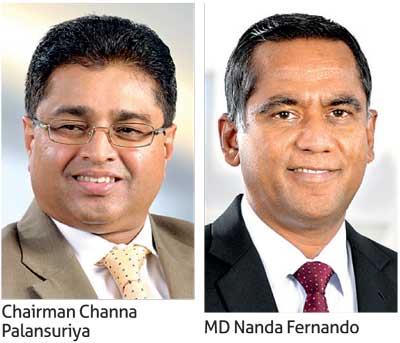08 Aug 2017 - {{hitsCtrl.values.hits}}
Sampath Bank PLC reported earnings of Rs.18.72 a share or Rs.3.49 billion profit for the quarter ended June 30, 2017 (2Q17), an increase of 39.1 percent from a year ago, mainly due to a jump in exchange and dividend incomes.
The strong growth in the loan book also helped the bank to cushion its bottom line.
For the six months ended in June, the bank with an asset base of Rs.725 billion, posted a net profit of Rs.5.9 billion or Rs.31.54 a share.

The bank received some sizable realized exchange income and dividend income recognized under the operating income propelling the bank’s profit by around
Rs.700 million.
During the six months, the bank has reduced its money market lending by around Rs.33 billion and increased its financial investments under the trading category by close to
Rs.40 billion.
Also, during the same period, the bank expanded its loan book by a staggering Rs.56.2 billion, recording an increase of 12.0 percent year-on-year (YoY).
During the April-June quarter, the growth was Rs.26 billion in new loans.
The bank on a stand-alone basis has a loan book of Rs.522.1 billion. Total assets grew by 10.1 percent to Rs.725.3 billion.
Generally, the credit growth during the second half of the year is stronger than the first half, according to the historical data.
MD Nanda Fernando
However, if the first half is an indication of the growth to be during the second half, Sampath Bank would end up loaning a whopping Rs.113 billion in new loans in 2017. During the first six months, Sri Lanka’s banking sector granted a total credit of Rs.300 billion in private sector credit. Meanwhile, the bank appears to have fully funded the growth in loans through customer deposits, which grew by Rs.61.7 billion or 12 percent YoY to Rs.571.4 billion by June 30. However, the low-cost deposits measured through the current and savings accounts (CASA) ratio continued to fall to little above 36 percent from around 39 percent six months ago.
The net interest income rose by 23.7 YoY to Rs.7.2 billion although the interest expense rose significantly higher than the interest income. The interest expense for the period rose by 66.9 percent YoY while the interest income rose by 48.4 percent YoY. The net interest margin edged down to 3.83 percent from 3.87 percent in December 2016. Meanwhile, the net fee and commission income rose by 22 percent YoY to Rs.1.92 billion. The specific provisions declined by a half while the general provisions rose to Rs.487 million from a provision reversal of Rs.42.5 million a year ago.
The gross non-performing loan ratio rose to 1.77 percent from 1.61 percent in the beginning of the year but still remains well below the industry average. The bank’s Tier I and Tier II capital adequacy ratios stood at 8.21 percent and 12.17 percent, respectively, slightly higher than the BASEL III minimum requirements of 7.75 percent and 11.75 percent. The bank recently announced a Rs.8.0 billion rights issue and a Rs.6.0 billion convertible subordinated debenture to prop up capital. Dhammika Perera-controlled Vallibel One PLC held a 14.95 percent stake in the bank followed by a 9.99 percent stake by high-net-worth investor Indra Silva. The Employees’ Provident Fund held a 9.97 percent stake being the third largest shareholder.
10 Jan 2025 1 hours ago
10 Jan 2025 2 hours ago
10 Jan 2025 2 hours ago
10 Jan 2025 2 hours ago
10 Jan 2025 2 hours ago